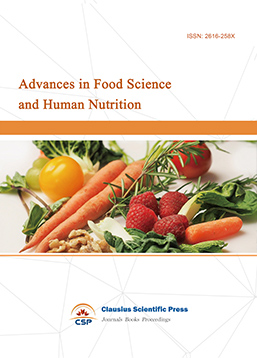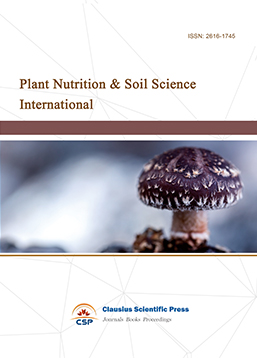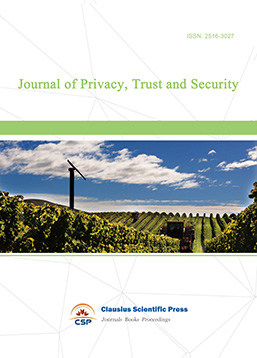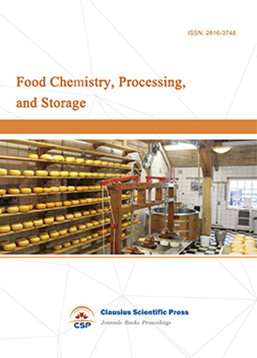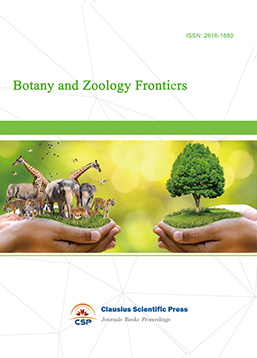Effects of Microbial Biochar-Based Fertilizer on Yield and Quality of Rice in Cadmium-Contaminated Paddy Fields
DOI: 10.23977/jmcs.2024.030101 | Downloads: 27 | Views: 1893
Author(s)
Jing Qian 1, Peng Zhu 1, Junhao Deng 1, Xiaoying Peng 1, Huiqun Wang 1
Affiliation(s)
1 College of Bioscience & Biotechnology, Hunan Agricultural University, Changsha, Hunan, 410128, China
Corresponding Author
Xiaoying PengABSTRACT
A randomized block design was used to set up three treatments: "biochar-based fertilizer + microbial inoculant + silicon foliar fertilizer" (microbial biochar-silicon fertilizer), "biochar-based fertilizer + microbial inoculant" (microbial biochar-based fertilizer), and regular compound fertilizer (control). A large-scale demonstration of the field effectiveness of microbial biochar-silicon fertilizer was also conducted. The study investigated its effects on the growth physiology and grain cadmium content of rice variety Longjing Youdi in cadmium-contaminated soil. The results showed that the net photosynthetic rate of rice flag leaves during the grain-filling stage in the microbial biochar-silicon fertilizer and microbial biochar-based fertilizer treatments was significantly different from the control, with the order being microbial biochar-silicon fertilizer > microbial biochar-based fertilizer > regular fertilizer. Microbial biochar-based fertilizer can enhance the rice's physiological resistance, improve the photosynthetic capacity during the booting, heading, and grain-filling stages, and increase the plant height and relative yield at harvest. The rice in the microbial biochar-silicon fertilizer demonstration fields grew uniformly and had full grains. Field measurement results showed that the actual yield of the microbial biochar-silicon fertilizer demonstration model was 558.6 kg/667m2, an increase of 9.2% compared to the control model. The grain cadmium content in the microbial biochar-silicon fertilizer demonstration model was 0.225 (mg/kg), a reduction of 79.0% compared to the control model. The effects of increasing yield and reducing grain cadmium content in the microbial biochar-silicon fertilizer demonstration model were significant, thereby improving grain quality.
KEYWORDS
Microbial Biochar-Based Fertilizer, Rice, Growth Physiology, CadmiumCITE THIS PAPER
Jing Qian, Peng Zhu, Junhao Deng, Xiaoying Peng, Huiqun Wang, Effects of Microbial Biochar-Based Fertilizer on Yield and Quality of Rice in Cadmium-Contaminated Paddy Fields. Journal of Modern Crop Science (2024) Vol. 3: 1-9. DOI: http://dx.doi.org/10.23977/jmcs.2024.030101.
REFERENCES
[1] Galloway J N, Townsend A R, Erisman J W, et al. Transformation of the nitrogen cycle: Recent, trends, questions, and potential solutions. Science, 2008, 320: 889-892.
[2] Juahir H, Zain SM, Yusoff M K, et al. Spatial water quality assessment of Langat River Basin (Malaysia) using environ metricschines. Environ Monit Assess, 2011, 173(4): 625-641.
[3] Moller K, Stinner W, Leithold G. Growth, composition, biological N 2 fixation and nutrient uptake of a leguminous cover crop mixture and the effect of their removal on field nitrogen balances and nitrate leaching risk. Nutr. Cycl.Agroeco-system, 2008, 82: 233-249.
[4] Atar N, Olgun A, Wang S. Adsorption of cadmium (II) and zinc (II) on boron enrichment process waste in aqueous solutions: Batch and fixed-bed system studies. Chemical Engineering Journal, 2012, 192: 1-7.
[5] He S, Li Y, Weng L, et al. Competitive adsorption of Cd2+, Pb2+ and Ni2+ onto Fe3+-modified argillaceous limestone: Influence of pH, ionic strength and natural organic matters. Science of the Total Environment, 2018, 637: 69-78.
[6] Huang G, Su X, Rizwan M S, et al. Chemical immobilization of Pb, Cu, and Cd by phosphate materials and calcium carbonate in contaminated soils. Environmental Science and Pollution Research, 2016, 23(16): 16845-16856.
[7] Abedin M J, Meharg A A. Relative toxicity of arsenite and arsenate on germination and early seedling growth of rice (Oryza sativa L.). Plant and Soil, 2002, 243(1): 57-66.
[8] Uraguchi S, Mori S, Kuramata M, et al. Root-to-shoot Cd translocation via the xylem is the major process determining shoot and grain cadmium accumulation in rice. Journal of Experimental Botany, 2009, 60(9): 2677-2688.
[9] Sun Jifeng, Wang Xu. Advances in the Research and Application of Soil Conditioners. Chinese Journal of Soil and Fertilizer, 2013 (1): 1-7.
[10] Lehmann J, Rillig M C, Thies J, et al. Biochar effects on soil biota–a review. Soil biology and biochemistry, 2011, 43(9): 1812-1836.
[11] Luyima D, Lee J H, Yoo J H, et al. Post–pyrolysis nutrient enhancement of wood biochar with compost and uncharred wastes–influence on soil chemical properties and crop productivity. Journal of the Faculty of Agriculture Kyushu University, 2019, 64(2): 199-204.
[12] Oldroyd G E D. Nodules and hormones. Science, 2007, 315(5808): 52-53.
[13] Hussain A, Hasnain S. Cytokinin production by some bacteria: its impact on cell division in cucumber cotyledons. African Journal of Microbiology Research, 2009, 3(11): 704-712.
[14] Liu Keyi, Pan Che, Peng Jing, et al. Effects of Cytokinin-Producing Bacteria on the Early Growth Physiology of Potatoes. Hunan Agricultural Science, 2012 (1): 12-14.
[15] Li D, Dai B, Zeng X, et al. Reduction of heavy metal cadmium accumulation in rice grains. Journal of Bionanoscience, 2015, 9(5): 383-388.
[16] Jia Qian, Hu Min, Zhang Yangyang, et al. Effects of Potassium and Silicon Fertilizer Application on the Absorption of Lead and Cadmium by Rice. Journal of Agro-Environment Science, 2015 (12): 2245-2251.
[17] Peng Hua, Tian Faxiang, Wei Wei, et al. Effects of Silicon Fertilizer Application at Different Growth Stages on the Absorption and Accumulation of Cadmium and Silicon in Rice. Journal of Agro-Environment Science, 2017, 36(6): 1027-1033.
[18] Ji X, Liu S, Juan H, et al. Effect of silicon fertilizers on cadmium in rice (Oryza sativa.L) tissue at tillering stage. Environmental Science and Pollution Research, 2017, 24(11): 10740-10748.
[19] Li D, Dai B, Zeng X, et al. Reduction of heavy metal cadmium accumulation in rice grains. Journal of Bionanoscience, 2015, 9(5): 383-388.
[20] Schulz H, Glaser B. Effects of biochar compared to organic and inorganic fertilizers on soil quality and plant growth in a greenhouse experiment. Journal of Plant Nutrition and Soil Science, 2012, 175(3): 410-422.
[21] Van Zwieten L, Kimber S, Morris S, et al. Effects of biochar from slow pyrolysis of papermill waste on agronomic performance and soil fertility. Plant and soil, 2010, 327(1-2): 235-246.
[22] Caverzan A, Passaia G, Rosa S B, et al. Plant responses to stresses: role of ascorbate peroxidase in the antioxidant protection. Genetics and molecular biology, 2012, 35(4): 1011-1019.
[23] Tanabe S, Ishii-Minami N, Saitoh K I, et al. The role of catalase-peroxidase secreted by Magnaporthe oryzae during early infection of rice cells. Molecular plant-microbe interactions, 2011, 24(2): 163-171.
[24] Alscher R G, Erturk N, Heath L S. Role of superoxide dismutases (SODs) in controlling oxidative stress in plants. Journal of experimental botany, 2002, 53(372): 1331-1341.
[25] Li Li, Lu Yuchao, Liu Ya, et al. Study on the Adsorption Mechanism of Cd (II) by Corn Straw Biochar. Journal of Agro-Environment Science, 2012, 31(11): 2277-2283.
[26] Liu Mingda. Methods for Evaluating the Silicon Supply Capacity of Paddy Soil and the Effect of Silicon Fertilizers on Rice. Shenyang: College of Land and Environment, Shenyang Agricultural University, 2002.
[27] Hu Ruizhi, Fang Shuijiao, Chen Guiqiu. Effects of Silicon on Physiological Indices and Yield of Hybrid Rice. Journal of Hunan Agricultural University: Natural Sciences, 2001, 27(5): 335-338.
[28] Xu Jiaying, Zhu Lianfeng, Yu Shengmiao, et al. Advances in the Study of the Effects of Silicon Fertilizer on Rice Yield and Physiological Characteristics. China Rice, 2012, 18(6): 18-22.
[29] Egamberdieva D. The role of phytohormone producing bacteria in alleviating salt stress in crop plants. Biotechnological techniques of stress tolerance in plants. Studium, Houston, TX, 2013: 21-39.
[30] Zhang Wenling, Li Guihua, Gao Weidong. Effects of Biomass Char on Soil Properties and Crop Yield. Chinese Agricultural Science Bulletin, 2009, 25(17): 153-157.
[31] Xu Yi, Xue Shuai, et al. Effects of CTK Bacterial Agent on Nutrient Accumulation and Rhizosphere Microorganisms of Melons. Journal of Yangzhou University: Agricultural and Life Science Edition, 2017, 38(2): 100-105.
[32] Yang Qiao, Zhao Long, Sun Zaijin, et al. Study on the Passivation Effects of Composite Passivators on Cadmium-Contaminated Farmland Soil in Irrigation Areas. Applied Chemical Industry, 2017, 46(6): 1037-1041.
[33] Vaculík M, Lux A, Luxová M, et al. Silicon mitigates cadmium inhibitory effects in young maize plants. Environmental and Experimental Botany, 2009, 67(1): 52-58.
| Downloads: | 689 |
|---|---|
| Visits: | 52448 |

 Download as PDF
Download as PDF